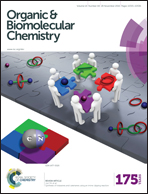Complexation between a triptycene-derived oxacalixarene and π-extended viologens: linker-length-dependent orientation of the macrocycles in pseudo[3]rotaxanes†
Abstract
With an expanded electron-rich cavity and a fixed conformation, macrocycle H was found to encapsulate π-extended viologens G1–G4 to form the first case of pseudo[3]rotaxanes based on oxacalixarenes. The complexation was investigated in detail both in solution and in the solid state using NMR spectroscopy and X-ray crystallography. Due to the three-dimensional nonsymmetric structure of H, three orientational isomers of the pseudorotaxanes could be expected theoretically. However, as the crystal structure analysis revealed, only one of the three isomers was obtained with either G1 or G3. Moreover, with regard to the different lengths of the linkers in the guest molecules, completely opposite orientations of the macrocycles on the axles were observed, which could be explained by different complexation modes between the components in the pseudo[3]rotaxanes. Additionally, the complexation between the host and the guest could be reversibly switched on and off using a suitable acid and base. These results will provide us with the opportunity to design and elaborately regulate high-order molecular devices.
![Graphical abstract: Complexation between a triptycene-derived oxacalixarene and π-extended viologens: linker-length-dependent orientation of the macrocycles in pseudo[3]rotaxanes](/en/Image/Get?imageInfo.ImageType=GA&imageInfo.ImageIdentifier.ManuscriptID=C6OB02093C&imageInfo.ImageIdentifier.Year=2016)

 Please wait while we load your content...
Please wait while we load your content...